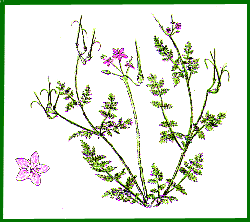|
Storksbill


 The Storksbill (Erodium cicutarium) was introduced to this
country from the Mediterranean region. It was brought to California for its
forage value, by Franciscan missionaries. It is now widely distributed over
most of the United States. It is a member of the Geranium Family. It is
known by many common names -- Filaree, Alfilaria, Pinkets, and Cranesbill
being some of the better known. The scientific name, Erodium,
is derived from a Greek word meaning heron. It is the immature seed pods
(which resemble the heads of herons or storks) that account for this name.
When mature, these pods split into five sections, each tipped by an
elongated corkscrew shaped tail (style). These coil spirally when dry, and
untwist when moistened. This device aids the pointed seed to penetrate the
soil.
The Storksbill (Erodium cicutarium) was introduced to this
country from the Mediterranean region. It was brought to California for its
forage value, by Franciscan missionaries. It is now widely distributed over
most of the United States. It is a member of the Geranium Family. It is
known by many common names -- Filaree, Alfilaria, Pinkets, and Cranesbill
being some of the better known. The scientific name, Erodium,
is derived from a Greek word meaning heron. It is the immature seed pods
(which resemble the heads of herons or storks) that account for this name.
When mature, these pods split into five sections, each tipped by an
elongated corkscrew shaped tail (style). These coil spirally when dry, and
untwist when moistened. This device aids the pointed seed to penetrate the
soil.

 This plant adapts to a variety of soils and moisture conditions, and
therefore has been able to crowd out many native plants. The seeds may
sprout in the fall, producing attractive basal rosettes if fall rains are
sufficient, and then furnishes winter forage. These rosettes also permit
early growth in the spring. If fall moisture is deficient, the seeds
germinate rapidly in the spring, crowding out plants from late germinating
seeds. Its way of growth permits survival under heavy grazing. It is a
nutritious food, especially in Arizona and California. Young plants can be
eaten as greens either raw or cooked.
This plant adapts to a variety of soils and moisture conditions, and
therefore has been able to crowd out many native plants. The seeds may
sprout in the fall, producing attractive basal rosettes if fall rains are
sufficient, and then furnishes winter forage. These rosettes also permit
early growth in the spring. If fall moisture is deficient, the seeds
germinate rapidly in the spring, crowding out plants from late germinating
seeds. Its way of growth permits survival under heavy grazing. It is a
nutritious food, especially in Arizona and California. Young plants can be
eaten as greens either raw or cooked.

 Leaves are pinnately dissected and toothed. Flowers, on stalks in umbel
clusters, are pink to purple with darker veins. Flowers have five sepals
and five petals. In some areas flowers are to be found throughout the year.
In others, the plants mature early, dry up and disappear, leaving their
seeds to sprout when conditions are favorable.
Leaves are pinnately dissected and toothed. Flowers, on stalks in umbel
clusters, are pink to purple with darker veins. Flowers have five sepals
and five petals. In some areas flowers are to be found throughout the year.
In others, the plants mature early, dry up and disappear, leaving their
seeds to sprout when conditions are favorable.


|
|
